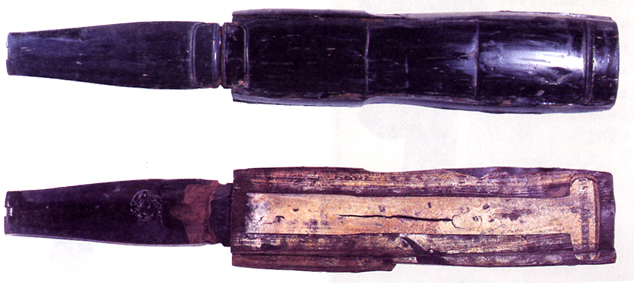Story of The Invention of Guqin
Right now, there is no evidence that shows what the first or the earliest guqin looks like.
So far the closest relatives of the qin probably are the 7 string qin that was found at the Warring states period tomb from
Hubei Province, in 荊門 Jīngmén 郭家店 Guō jiā diàn,(see photo below, from the book of Juéshì qīngyīn, page 8, written by Prof.
Wú Zhao in Beijing, year 2005).  And the 10 stringed qin from the tomb of Cénghóu Yǐ 曾侯乙, in Léigǔ dūn, Suízhou city 擂鼓墩 隋州市, Hubei Province. Fifth century B.C. (see photo below, from the book of Music in the Age of Confucius, page 70, published by Smithsonian Freer Gallery of Art and Arthur M. Sakler Gallery, Washington, D.C. year 2000).  But we still don’t know when and who decided to create the 13 dots, the dragon pond, the phoenix pool, and some other features. History books mentioned that the qin was first created with 5 strings, and then the King of wen and the King of wu from the Zhou dynasty (1045BC-256 BC) added the 6th and 7th strings. There were once added to a total of 9 strings, but it was not really popular and the 7 stringed qin continues to be used until now. There are some legends about the invention of the Guqin, that this or that king or wise man invented the qin.
Shen-nong make qin, shen-nong’s qin has 3’6” inches long with 5 string.-- from "Shi Ben," a history book of Zhao, Warring states
period BC235~BC228. (Shen-nong was one of the Chinese legendary god who also nown as Emperor of the Five Grains .)
When Shen-nong became the ruler, he started to carve tong wood to make a qin and use silk to make strings to connect the heaven
and earth.-- from Huan Tan Xin Lun, a Han Dynasty history book, about BC 50~ BC 30.
King of Jun’s son Dragon Yan makes qin and se. -- from a fable story book of early Qin Dynasty and probably written during the
warring states period to early Han dynasty.
From one of The Confucian book, the book of rites says that King Shun make 5 string qin to sing the southern song. Those legends seem to tell us that people believe that the qin was created by talented or enlightened wise people, and was in a lofty class.
Some people guess that ancient people found out that strings can make a sound probably from bow shooting that the vibration of
a string after shooting out the arrow. Then later people tried to put strings on a piece of wood and pluck it to create sound.
If we look at the ancient Chinese characters of Qin 琴(the zither) and Yue 樂 (music) from East Han dynasty, Xu Sheng 許慎(about 58
to 147 AD) edited the Chinese dictionary “Shuo Wen Jie Ji 說文解字,” Some people think that the qin in very ancient times could be played as a Fa Qi 法器, which means a instrument of wizard. Because they believe that the qin has its nature that can connect the heaven and earth. But at that time, the qin probably could only play single notes and probably just the right hand plucking only, without the left hand to change or create more pitches. Qin also was played in court music during the time of Zho Dynasty (1045BC-256 BC). However in court music, the percussion instruments and wind instruments dominated most of the playing and the qin or other string instruments were not the major players. Probably caused by the low sound volume. After Confucius, the qin became one of the four important items in a scholar’s life (qin qi shu hua 琴棋書畫 -- qin, chess, calligraphy and painting), and there was this saying: shi wu gu bu che qin se 士無故不撤琴瑟, which means that scholar should never give up playing Qin and Se (Se is another kind of string instrument). Qin was performed as a solo instrument and as a tool to xiu sheng yiang xing 修身養性; a meditation instrument to help cultivate our mind and body.
Connection between Qin and Taoism.
| |||
